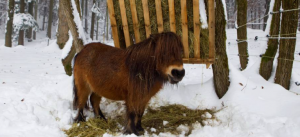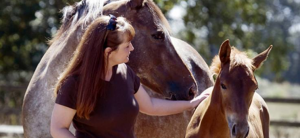Horses need vitamins A, B, C, D, E, and K for optimal health. The quantities needed are small, but the effects are important. For some vitamins, too much in the horse’s diet is just as bad as too little. Most of the well-known commercial horse feeds supply vitamins in the proper quantities, taking the guesswork out of feeding horses.
Vitamin A and its precursor, beta-carotene, are supplied by ingested material. It is one of the fat-soluble vitamins, meaning that it is easily stored in the body. Horses get vitamin A from eating fresh grass and good-quality hay. Any that is not used immediately is stored in the horse’s liver, and this supply is drawn upon during the winter months when pastures are dormant. Vitamin A is used to support eye function, reproduction, and the health of bones, skin, and muscles. A diet deficient in vitamin A can cause reproductive problems, increased risk of infection, defects in bone and muscle growth, a dull hair coat, and eye problems like tearing and night blindness. Too much vitamin A produces some of the same signs as well as weight loss and neurologic problems.
What we refer to as vitamin B is actually a complex of several substances including niacin, thiamine, biotin, cobalamine, folacin, riboflavin, and pantothenic acid. Because vitamin B is one of the water-soluble vitamins, extra supplies do not build up in the horse’s body. This means that new supplies must be added regularly, but toxicity isn’t a problem because excess B compounds are excreted instead of being stored. B vitamins are made in the horse’s body either from organic compounds in other foods, or by the microbes that live in the horse’s gut. Horses on a normal diet usually have adequate supplies of all the B complex substances, and toxicity has not been reported.
Another water-soluble nutrient is vitamin C, or ascorbic acid. Humans drink citrus juices to obtain vitamin C, but the horse’s liver is able to synthesize this nutrient from glucose. Vitamin C is necessary for proper formation of bones, teeth, and collagen, and is also a powerful antioxidant that protects cell membranes from the damaging action of free radicals. Older horses and those that have been sick or under stress may benefit from a bit more dietary vitamin C. There’s little danger of oversupplementing because this vitamin is poorly absorbed from the digestive tract, and excess amounts are excreted in the urine.
Vitamin D is a fat-soluble vitamin produced in the skin when horses are exposed to sunlight. It’s also found in hay, but decreases as the hay is stored. It is important for proper skeletal development in young horses and helps to regulate calcium and phosphorus levels in mature animals. Too little vitamin D leads to bone deformities, while oversupplementation can cause stiffness of joints and muscles, deposition of calcium in the horse’s internal organs, and even death.
Like vitamins A and D, vitamin E is present in grass and fresh hay, but levels decline as the hay ages. Alfalfa hay is a better source than grass hay. This fat-soluble vitamin has important antioxidant qualities and also supports healthy function of the horse’s nervous, immune, and reproductive systems. Horses that don’t get enough vitamin E may show muscle trembling, weakness, and atrophy. Equine motor neuron disease, or EMND, is caused by a vitamin E deficiency and is characterized by increased recumbency and loss of muscle tone. Horses appear to be tolerant of high levels of this vitamin.
Needed for proper blood clotting, vitamin K is manufactured in the horse’s hindgut and is also ingested in hay. Under normal conditions, it’s rare for a horse to develop a deficiency, but intestinal infections that disrupt the bacterial population of the gut can compromise production of vitamin K. Grazing sweet clover can also lead to a low level of vitamin K, producing signs like internal bleeding, pale mucous membranes, and an irregular heartbeat.
As grazers, horses naturally meet their vitamin requirement by ingesting grass or hay. Owners should allow as much turnout on good quality pasture as possible and provide hay that has not been stored for more than a few months. Most fortified commercial grain products are formulated to contain the correct levels of the vitamins horses need to consume. Horses that don’t need the calories in grain-rich feeds can look for a balancer pellet that provides vitamins and minerals in a low-calorie formulation. It’s important to avoid oversupplementation of vitamins, so owners should ask an equine nutritionist to evaluate their horses’ diets before adding supplements. The nutritionist can advise whether extra vitamins are needed for some classes of horses, such as those in extreme exercise programs.
 Evaluating hay feeders for horses can help you reduce waste. As one of the most common forages fed to horses, hay can be offered on the ground. It is also fed in a net, or in some type of feeder. Hay is often scattered and trampled by horses, reducing the percentage that is consumed when it is fed from the ground. Nets and feeders are designed to keep hay available, dry, and contained so it can be eaten rather than wasted.
Evaluating hay feeders for horses can help you reduce waste. As one of the most common forages fed to horses, hay can be offered on the ground. It is also fed in a net, or in some type of feeder. Hay is often scattered and trampled by horses, reducing the percentage that is consumed when it is fed from the ground. Nets and feeders are designed to keep hay available, dry, and contained so it can be eaten rather than wasted.
 Vitamins are defined as organic substances that are necessary for the proper nutrition of plants and animals. Ingested in minute quantities, vitamins act as coenzymes and precursors of coenzymes in the regulation of many metabolic processes. Some vitamins must be provided by food, while others are produced within the body. Not all animals are able to produce the same vitamins, which is one reason feeds designed for one species are not necessarily suitable for another type of animal.
Vitamins are defined as organic substances that are necessary for the proper nutrition of plants and animals. Ingested in minute quantities, vitamins act as coenzymes and precursors of coenzymes in the regulation of many metabolic processes. Some vitamins must be provided by food, while others are produced within the body. Not all animals are able to produce the same vitamins, which is one reason feeds designed for one species are not necessarily suitable for another type of animal.